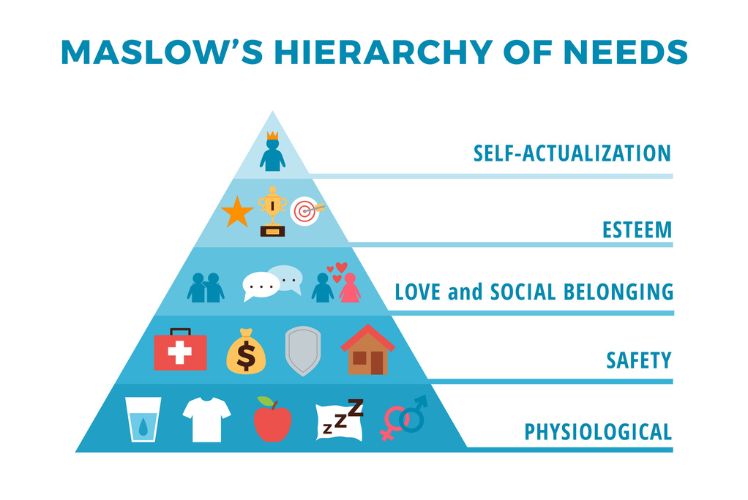Most of us want to know what truly motivates people in life, and that’s why Maslow’s hierarchy of needs continues to interest psychologists and everyday thinkers alike. Maslow’s pyramid is a model that shows how human needs are stacked, starting from the basics like food and safety, to deeper needs such as belonging, esteem, and self-actualisation. Understanding these layers helps us see why we act in certain ways and what drives our choices.
This pyramid of needs, created by Abraham Maslow in the 1940s, suggests that our most basic needs must be met before we care about higher-level goals. Each level—from survival needs at the bottom to personal growth at the top—represents a step in human motivation that many of us can recognise from our own lives. If you’re curious about how this model works, what each level means, and how it could apply to everyday situations, this article will give you a clear and simple overview.
If you want to read more about how these needs are organised, sites like Simply Psychology offer a detailed look at Maslow’s hierarchy of needs.
Key Takeaways
- Maslow’s pyramid explains how human needs are organised in a hierarchy.
- The theory covers basic needs, social belonging, esteem, and self-actualisation.
- Critics have modernised and debated the model, but it still shapes how we view motivation.
Origins and Core Concepts of Maslow’s Hierarchy of Needs
Maslow’s hierarchy has shaped how we think about human motivation in psychology. The model outlines different needs, arranged from the most basic survival needs to the desire for personal growth, showing how one level of needs must usually be met before moving up.
Abraham Maslow and the Birth of Motivational Theory
Abraham Maslow was an American psychologist who played a key role in developing motivational theory. He wanted to understand what drives people, moving beyond the ideas of behaviourism and psychoanalysis that dominated psychology at the time. Maslow’s focus was on positive human qualities and the potential for growth rather than just treating mental illness.
Maslow introduced his ideas in the 1943 paper “A Theory of Human Motivation.” He proposed that people are motivated by a set of needs that could be arranged in a hierarchy, leading to his well-known pyramid model. Maslow’s ideas quickly gained attention and influenced how we study human motivation in schools, workplaces, and even therapy settings. Today, his hierarchy remains a central topic in motivational psychology and is often used to explain why people behave in certain ways.
The Theory of Human Motivation
The pyramid is built on Maslow’s theory of human motivation. According to Maslow, motivation starts with our most urgent needs and moves up as we satisfy each level. These needs are both physical and psychological, and our actions are shaped by whichever needs are most pressing.
The five original levels Maslow included were:
- Physiological needs: basic things like food and water
- Safety needs: feeling safe and secure
- Love and belonging: close relationships, friendships
- Esteem: feeling respected by ourselves and others
- Self-actualisation: achieving our full potential
The idea is that lower needs must be fairly well met before we focus on higher ones. This step-by-step structure gives us a way to think about what motivates us at different times in life, making it a practical tool for understanding motivation.
Understanding the Needs Pyramid
Maslow’s hierarchy is often shown as a pyramid because the bottom layers support those above. The widest, bottom layer stands for basic survival needs, while the top shows personal growth and self-fulfilment. This visual makes it clear why we must first meet lower needs—such as hunger or safety—before we care about bigger goals.
The original version has five levels, but later expansions added layers like cognitive needs and self-transcendence. Most important is that the pyramid is a guide, not a strict rule. People might sometimes work on higher needs even if all lower needs aren’t fully satisfied.
For an easy-to-read overview, tables and diagrams—such as pyramid diagrams of Maslow’s hierarchy—can help us quickly see how each level fits within motivational theory.
The Five Levels of Needs in the Maslow Pyramid
Maslow’s hierarchy of needs helps us understand what drives human behaviour. The first two levels form the foundation, focusing on our most basic needs for survival and security.
Physiological Needs
The first level of the needs pyramid is physiological needs. These are the basic requirements for human survival. We cannot live without these essentials. Physiological needs include air, water, food, shelter, sleep, and clothing.
If these basic needs are not met, our bodies cannot function properly. We might suffer from dehydration, hunger, or sleep deprivation. When people experience food insecurity, they struggle to focus on anything beyond finding their next meal. Maintaining homeostasis is a key factor here—our body must balance things like temperature, energy, and hydration for us to live and grow.
Healthcare, clean air, and stable access to nutritious food are vital at this level. Many people around the world still face challenges meeting their physiological needs, which can impact their health, mood, and performance at school or work. More about physiological needs can be found in this overview of Maslow's hierarchy.
Safety Needs
The second level of the hierarchy of needs is safety needs. Once our basic physical needs are met, we turn our attention to feeling safe and secure. Safety and security are important to prevent harm, anxiety, or danger.
Safety needs include personal security, financial stability, health protection, and a safe home. We seek steady employment, access to healthcare, and protection from violence or accidents. In childhood, a stable home and trustworthy adults are critical for meeting these needs.
When safety needs are not met, people often struggle with stress and uncertainty. Natural disasters, war, or unstable housing can make us feel unsafe. Meeting safety and security needs is necessary for us to move further up the levels of need in the hierarchy. For many, these are known as deficiency needs or d-needs because lacking them creates discomfort and distress.
Belonging, Esteem, and Self-Actualisation
Humans need to feel connected to others, valued by themselves and peers, and have chances to reach their full potential. These three levels—belonging, esteem, and self-actualisation—make up the higher-order needs in Maslow’s hierarchy.
Love and Belonging
After basic physical and safety needs are satisfied, the need for love and belonging becomes important. This includes our desire for friendship, affection, and intimacy. We seek acceptance from our family, friends, and social groups.
When we feel loved and included, our sense of belongingness grows. This feeling supports our happiness and helps us build trust with others. Strong, healthy relationships encourage emotional stability.
Love needs are not just about romantic relationships. They also involve meaningful connections at school, work, and in our communities. Social rejection or loneliness can harm our mental health and make it harder to meet other needs. Fulfilling our belonging needs often leads to improved motivation and greater well-being, as shown in studies of Maslow's hierarchy.
Esteem Needs
When we feel accepted, we begin to crave respect, self-worth, and accomplishment. Esteem needs are about gaining both self-esteem and the esteem of others. This means we want to feel confident and capable in what we do.
Recognition from family, friends, or colleagues helps us build our sense of achievement. Some ways people meet esteem needs include setting goals, gaining new skills, and taking pride in their work. Feeling respected encourages us to strive further and show initiative.
If these needs are not met, we may feel weak or useless. On the other hand, meeting esteem needs can lead to greater independence and happiness. Esteem is about more than just praise; it is also feeling capable and valued for our contributions, as explained in detailed reviews of Maslow’s hierarchy.
Self-Actualisation
Once we feel loved and respected, we begin to look for self-fulfilment and personal growth. Self-actualisation is the process of reaching our highest potential and becoming the best version of ourselves. This stage is often described as a growth need or higher-order need.
People experience self-actualisation in many ways, such as creating art, solving problems, or finding purpose in their life. It is about using our talents and pursuing activities that are meaningful to us. Not everyone reaches this stage, but everyone has the potential for it.
Self-actualising does not mean being perfect. It means we are seeking growth, learning, and self-discovery. This pursuit is unique to each of us, as self-actualisation looks different depending on our interests, values, and dreams. Learn more about this level with this overview of Maslow’s concept.
Practical Applications and Examples of Maslow’s Pyramid
Maslow’s pyramid helps us understand how people’s needs guide their behaviour and choices. By seeing which needs are not met, we can create better support systems in areas like education, leadership, and mental health.
Real-Life Scenarios and Case Studies
In the workplace, Maslow’s hierarchy often shapes how teams and leaders motivate employees. For instance, employers who offer wellness programmes address physiological and safety needs, while recognition and leadership opportunities support esteem and self-actualisation. This approach can lead to better job satisfaction and stronger employee engagement.
When it comes to mental health services, professionals use the pyramid to identify unmet needs in their clients. People in financial insecurity may struggle with basic safety and physiological requirements, which can affect their ability to focus on personal growth. Addressing these fundamental issues is a first step before working on higher-level goals.
We also see practical application in community aid programmes. Shelters typically provide food, warmth, and safety first, then help people find stable housing and work through training, aiming for long-term independence and self-fulfilment. These examples demonstrate how Maslow’s model guides real decisions and support strategies.
Maslow’s Hierarchy in Education
Understanding Maslow’s hierarchy can help us create more effective learning and training environments. If students do not have their basic needs met—like food, rest, and safety—they often find it difficult to pay attention or retain information in lessons.
Schools and colleges often now provide breakfast clubs, quiet areas, and support staff. This supports students’ physiological and emotional needs, making it easier for them to focus on learning. For those facing social challenges, mentoring programmes and peer groups can help to build belonging and boost self-esteem.
Teachers are better equipped to recognise when a student’s lack of progress might be caused by unmet needs rather than lack of ability. By supporting the whole person, educators can help students succeed not just in tests but in personal growth as well. This approach creates a supportive foundation for lifelong motivation and well-being, as explained in detail on Maslow’s Hierarchy in Education.
Critical Perspectives and Modern Interpretations
Different experts have raised important questions about Maslow’s hierarchy of needs, especially when it comes to culture, individuality, and advances in psychology. The original model, while influential, is not without its critics and has evolved over the years.
Cultural Considerations and Individual Differences
Maslow’s pyramid suggests human needs follow a set order, but this is not true for everyone. In individualistic cultures, people may focus on personal success and self-esteem early on. However, in more collectivist societies, belonging and social roles may come first.
Research has shown that culture can shift the importance of each need. Not everyone values self-actualisation in the same way. Some people prioritise family or community over personal ambitions. We must also recognise that each person's experience is unique; needs may not always appear in a strict order.
A holistic view helps us understand these differences. This means looking at a person’s background, social ties, and environment. Maslow himself used biographical analysis, but his early work focused mostly on famous Americans, which limits the pyramid’s global application. Recent reviews, like those explained by Simply Psychology, highlight these challenges in applying the model across cultures.
Contemporary Developments and Alternatives
Modern psychology has updated and questioned the original five-step model. One change is adding new layers, like cognitive or aesthetic needs, above self-actualisation. Some experts suggest that self-transcendence, or helping others, belongs at the top.
There are also critics who argue that human motivation is too complex for a simple hierarchy. We may pursue several needs at once, and not always in the order Maslow described. Researchers point to evidence that needs like love or esteem can become urgent even if basic needs are unmet.
Alternatives to the pyramid have emerged. For example, some models use clusters of needs rather than steps. Others focus more on well-being or happiness instead of strict levels. We can read further about these critiques and new ideas in detail at Medical News Today and Verywell Mind.
Frequently Asked Questions
Maslow’s hierarchy of needs describes human motivation by dividing it into specific levels, starting from basic physical needs and moving up to personal fulfilment. This model is used in education, the workplace, and healthcare, but it has faced some criticism and updates over the years.
What are the five levels of the hierarchy of needs proposed by Maslow?
The five levels are physiological needs, safety needs, love and belonging, esteem, and self-actualisation. Each level builds on the previous one.
Our most basic needs are at the bottom of the pyramid, such as food and water. The top level, self-actualisation, is about reaching our full potential. More on these levels can be found in this article about Maslow's hierarchy of needs.
How does Maslow's concept of self-actualisation fit into his theory?
Self-actualisation is the highest level in Maslow’s model. It deals with personal growth, creativity, and fulfilling our unique potential.
We can only focus on self-actualisation after our lower needs, like safety and belonging, are met. People who reach this stage often pursue hobbies, learning, and new experiences.
In what ways can Maslow's hierarchy of needs be applied in practical settings?
Educators use the pyramid to ensure students’ basic needs are met before expecting higher academic achievement. Employers can apply it by creating safe and supportive workplaces that encourage personal development.
Healthcare professionals may use these levels to prioritise patient care, making sure physical well-being is secured before focusing on emotional and social support. Practical examples are explained in this overview of Maslow's pyramid.
What are the core principles underlying Maslow's theory of motivation?
Maslow’s theory is based on the idea that humans have needs ranked in a specific order. We tend to focus on meeting basic needs first.
Once our basic needs are met, we can move on to higher levels. Motivation increases as we progress through the pyramid, aiming for growth and self-improvement.
How has Maslow's hierarchy of needs been critiqued and refined over time?
Some critics say the pyramid does not apply equally across different cultures. Others argue that people do not always satisfy needs in order. Research has led to additions like cognitive and aesthetic needs above self-actualisation.
Some experts now view the hierarchy as more flexible and adaptable than the original version. Discussions on the uses and criticisms of Maslow's model show how it has changed.
Could you explain the significance of the physiological base in Maslow's pyramid?
Physiological needs are at the base and are the foundation of the pyramid. These include food, water, sleep, and shelter.
If these basic needs are not met, our focus stays on survival. Without satisfying physiological needs, it becomes difficult to focus on higher levels, such as social connections or personal growth.





















